Much, if not most, comics
storytelling concerns
the ongoing exploits of series characters. Also, many newspaper comic
strips, and most comic book series, have involved adventure or
fantasy. It's not surprising, then, that over the decades, the
Arthurian legend has been a rich source of material for writers and
artists in creating new stories of their own series
characters. And since most comics series have a contemporary
setting, Arthurian elements are often introduced through some form of
time travel, with the "Connecticut
Yankee" device of sending a modern-day character back in time to
Camelot being the most common.
The following list is only a sampling of the stories that have been produced, and is probably the least-complete section of the overall survey. I am very interested in receiving suggestions for additions, but let me hasten to add that I am not attempting to catalog every single passing mention of Excalibur or the Holy Grail in a comic book. The list focuses on comics stories where the use of Arthurian material is significant. (I grant that this is a subjective criterion.) I am happy to include stories from any comics genre, but I'm not planning to list one-panel gags or cover-only references. Stories that only allude to Arthurian themes through the names of characters or other elements are also considered beyond the scope of this survey, at least for the present. All suggestions will be carefully considered, but I reserve the right to decide what will be included on the page. (For a comprehensive annotated bibliography of American comic books with Arthurian references published from 1980 to 1998, please see Michael Torregrossa's excellent "Camelot 3000 and Beyond," available online. For a bibliography embracing all English-language comics, see Dan Nastali's and Phil Boardman's monumental 2-volume reference work, the Arthurian Annals.)
The entries are presented in alphabetical order by the name of the comics character or group of characters in whose series the stories take place. Publication information is presented where possible.
DC Comics' All-Star Squadron series, published in the 1980's, related the exploits of the Justice Society of America and their costumed colleagues (including the Shining Knight) in World War II. The fourth issue (Dec., 1981) answered the question of why the American superheroes didn't bring an end to the war immediately after Pearl Harbor, describing how a villain called the Dragon King used the power of the Holy Grail and the Spear of Destiny (held by Hideki Tojo and Adolf Hitler, respectively) to turn the heroes against each other when they entered territory controlled by the Axis. The Grail was lost sometime after the war, and the Dragon King began a decades-long search to recover it which eventually brought him into conflict again with the Shining Knight, as told in Stars and S.T.R.I.P.E. #11 (June, 2000).
The Anachronauts are a group of heroes from different time periods who, from their base in a centuries-spanning city called Chronopolis, investigate anomalies in the time stream. Among their number is Sir Raston, nephew of the original Black Knight, and like him a wielder of the Ebony Blade forged by Merlin from a meteorite called the Starstone. In a back-up story in Avengers Annual vol. 1, #22 (Marvel Comics, 1993), the Anachronauts visited Camelot to prevent the theft of the Starstone prior to its discovery by Merlin.
DC Comics' "King of the Seven Seas" met King Arthur (as well as Morgan Le Fay, Merlin, and Viviane, the Lady of the Lake) in Adventures in the DC Universe #15 (June, 1998). In this story, Aquaman was transported back in time to aid Viviane in her attempt to prevent Morgan from stealing the sword Excalibur before it could be claimed by Arthur. A few years later, the Sea King was involved in a storyline (beginning with Aquaman vol. 6, #1, 2002) in which he was chosen by a mysterious figure identifying herself as the Lady of the Lake to be a conduit for the healing power of the "Secret Sea".
Aquaman has also been associated with the Arthurian legend in more subtle ways. The Atlantean monarch, whose "surface-world" name is Arthur Curry, has occasionally been referred to as "King Arthur."
For another undersea ruler's Arthurian encounters, see the entry for Namor, the Sub-Mariner.
These
allied superheroes (published by Marvel Comics since 1963) have at
various times counted Captain America, Iron
Man, and Thor
(as well as the Black
Knight) among
their number. In addition
to their Arthurian adventures with the Black Knight and
Modred
the Mystic, the
Avengers met Merlin
(later deemed to have been an imposter) in Avengers
v.1, #10
(reprinted in hardcover in Marvel Masterworks: The Avengers,
Vol.1, and in black and white paperback format in Essential
Avengers, Vol. 1), and also battled against Morgan Le Fay and
Mordred on several occasions. They came to the aid of
Spider-Woman
in her struggle against Morgan in v.1, #240-241, and stood against
Morgan and Mordred when the former of the two villains magically
transformed the modern world into a medieval world in which she ruled
as queen (Avengers v.3, #1-3, 1998 ; reprinted in
trade
paperback as Avengers: The Morgan Conquest and in
the
hardcover collection Avengers Assemble, Vol. 1).
Morgan
returned in Avengers
v.3, #80-81 (2004), in which the Avengers joined
the new
Captain Britain
in thwarting the
sorceress' scheme to usurp the power of Avalon and destroy England.
More recently, Morgan has appeared in issues of Mighty Avengers
(#9 and 11, 2008) and Dark
Avengers
(#1-4, 2009) which explore her relationship with the
modern-day
arch-villain Doctor Doom, as first introduced in issues of Iron Man
(discussed below). Her most recent attempt at world conquest came
in several issues of Avengers
World (2014) which also featured the Black Knight.
In an earlier adventure, the
"West Coast"
version of the team came to the aid of the super-team
Excalibur at
the behest of the Lady of the Lake. Additionally, an incarnation
of the
team aimed at younger readers joined the Black Knight
in opposing
Morgan Le Fay in Marvel
Adventures: The Avengers #10. Marvel has also published
Avataars:
Covenant
of the Shield (2000), featuring medieval-fantasy versions of
the
Avengers and other Marvel heroes dwelling in the realm of Avalon on
an alternate Earth.
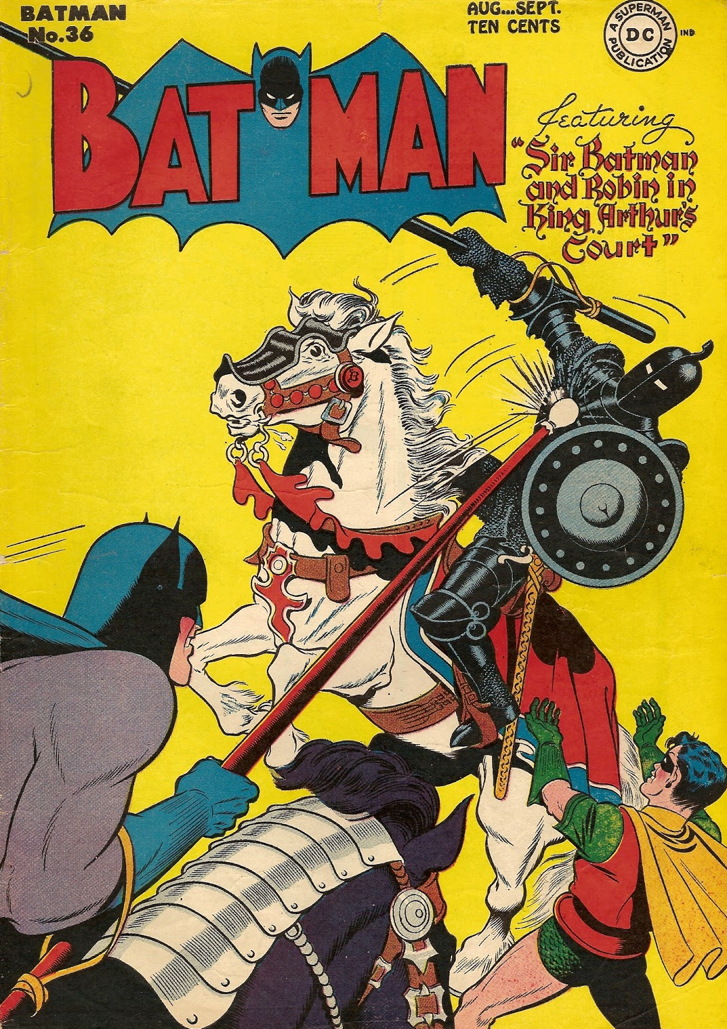 The
well-known hero of Gotham City (published by DC Comics), became "Sir
Batman at King Arthur's Court" in a story by that title that appeared
in issue #36 of the regular Batman series
(Aug./Sept., 1946).
Batman and Robin traveled through time to the Sixth Century and
joined Lancelot and the other Round Table Knights to rescue Merlin
from the hands of Mordred and Morgan Le Fay. Batman also journeyed to
Camelot with Superman
in World's
Finest, and he
has encountered Merlin's
demon,
Etrigan, on a
number of occasions. (In
one "Elsewords" story, in fact, Batman/Demon: A Tragedy
[2000], the title characters are merged, while Batman's
faithful butler Alfred is
The
well-known hero of Gotham City (published by DC Comics), became "Sir
Batman at King Arthur's Court" in a story by that title that appeared
in issue #36 of the regular Batman series
(Aug./Sept., 1946).
Batman and Robin traveled through time to the Sixth Century and
joined Lancelot and the other Round Table Knights to rescue Merlin
from the hands of Mordred and Morgan Le Fay. Batman also journeyed to
Camelot with Superman
in World's
Finest, and he
has encountered Merlin's
demon,
Etrigan, on a
number of occasions. (In
one "Elsewords" story, in fact, Batman/Demon: A Tragedy
[2000], the title characters are merged, while Batman's
faithful butler Alfred is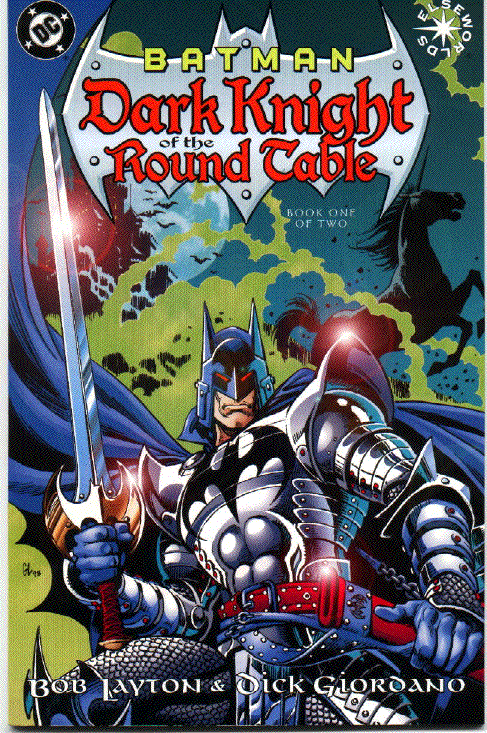 conflated with Merlin.)
In December, 1999,
DC Comics published the graphic novel, Batman: The Chalice,
in
which Batman became a reluctant guardian of the Holy Grail. The story
implied a possible familial connection between Batman (Bruce Wayne)
and Sir Gawain of the Round Table (in this reader's interpretation,
at least).
conflated with Merlin.)
In December, 1999,
DC Comics published the graphic novel, Batman: The Chalice,
in
which Batman became a reluctant guardian of the Holy Grail. The story
implied a possible familial connection between Batman (Bruce Wayne)
and Sir Gawain of the Round Table (in this reader's interpretation,
at least).
Contemporary comics writers as well as filmmakers often refer to the Batman as a "dark knight", and the character has been re-imagined as a literal Arthurian knight on at least two occasions. In Tangent Comics: The Batman (Sept., 1998) DC Comics introduced a new character with nothing in common with the familiar hero save the name. This Batman is the spirit of Sir William, a knight of King Arthur's time, animating a suit of armor to battle evil in present-day London. William had turned against Arthur at the behest of his wife, who turned out to be a disguised Morgan Le Fay, and William was cursed by Merlin to dwell a prisoner in his own castle, only emerging in spirit as the Batman, until he can atone for his crimes. A somewhat more traditional Batman appears in Batman: Dark Knight of the Round Table #1 and 2 (1999), an "Elseworlds" story in which Bruce of Waynesmoor is one of the male children banished by Arthur in an attempt to eliminate the threat of Mordred. Bruce's parents are slain at sea by Morgana Le Fay, and Bruce grows to manhood swearing vengeance on both Morgana and Arthur. Given the guise of the Batman by Merlin, Bruce ultimately plays a key role in the final conflict between Arthur and his ememies.
Christiana Blood (a medieval warrior) and Tamara Rose (a policewoman from the future) were adventurers striving to repair distortions in the space-time continuum in a few comics published by Knight Press in the mid-1990's. In Blood & Roses: Search for the Time-Stone #2 (1994), the two agents of the Time Lords travel to Arthur's court in Camelot and meet Arthur, Lancelot, Merlin, and others. (The story is set in the same fictional reality as the StormQuest series briefly published by Caliber at about the same time.)
Since 1990, DC Comics and its
Vertigo imprint
have published a number of miniseries and ongoing series chronicling
the adventures of Tim Hunter, an modern adolescent English boy
destined to become the greatest sorcerer of his era. Tim was
introduced in a four-issue miniseries, The Books of Magic,
written by Neil Gaiman (reprinted as a single-volume trade paperback
in 1991). In this story, four powerful magic workers (including
John
Constantine)
took Tim Hunter on a tour
of magic in the DC Universe, including a visit to a young Merlin in
the years before Arthur's kingship (issue #1, 1990).
Following a run of seventy-five issues (plus annuals, spin-off miniseries, etc.) of an ongoing Books of Magic title, Tim Hunter returned in the 2001 five-issue miniseries The Names of Magic. In this story, written by Dylan Horrocks, Tim underwent a quest to discover the truth of his identiy and origins which eventually led him to a cave at Tintagel (King Arthur's legendary birthplace) and another encounter with Merlin (issue #5). Tim learned that Merlin had created him in his dreams to serve (as Merlin had) as a conduit for magic, "the power once called the Myrddin -- the Merlin" and to battle the darkness that threatened to extinguish not only magic, but all Creation.
Tim's story continued in Hunter: The Age of Magic. In the early issues of this series, Merlin appeared as Tim's confidant and mentor of sorts, in the form of an owl familiar. Merlin apparently perished in issue #16 (December, 2002).
This character, a superheroine whose adventures took place in a Britain existing in the realm of Faerie, appeared in in a back-up feature in several issues of Hero Comics' short-lived black & white series Flare. A companion of Britannia's named Lance was introduced in Flare v.2, #12 (1993). The following issue strongly suggested that Lance was Sir Lancelot, who "for a thousand years and more... [had] been doing penance for his one great sin." (See the Iron Fist entry below for a similar treatment of Lancelot's survival.)
Marvel's third hero to bear the name Captain Marvel (none of whom bear any relation to the original "Marvel Family" character discussed below) became involved with a plot by Merlin (the "imposter" version introduced in Thor #96) to summon Grendel's mother (from the epic poem Beowulf) to aid him in his quest for the Holy Grail in Captain Marvel v.5, #20-21 (2001).
The
sardonic seaman Corto Maltese has been a fixture of European comics
for years in adventures written and illustrated by Hugo Pratt. In
Corto Maltese: A Mid-Winter Morning's Dream
(published in book
form, in English, by NBM in 1987), Maltese stands in for King Arthur
to foil a German ("Saxon") plot against Britain during World War I,
fulfilling a purpose laid out for him by the island's Faery
guardians, who include Morgana and Merlin.
The titular hero, a contemporary mercenary, was healed of a mortal illness by the Holy Grail in a story running through issues 6 - 9 of his eponymous Image Comics series (1994).
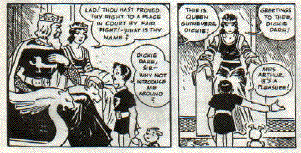
Writer-artist Milton Caniff's "Dickie Dare" is a boy who daydreams himself into worlds of adventure in this short-lived American newspaper comic strip, including (in 1933) the world of Arthurian romance. (This adventure was reprinted in book form by Fantagraphics in The Complete Dickie Dare in 1986.)
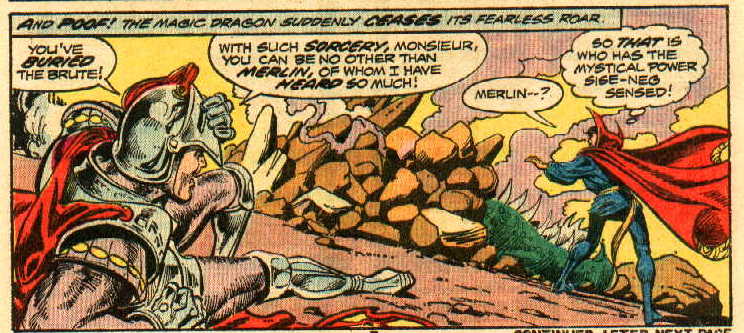 Marvel
Comics' sorcerous superhero Dr. Strange met Lancelot du Lac while
time-traveling in a story that appeared in Marvel Premiere
#14
(March, 1974; reprinted in black and white in Essential
Doctor
Strange, Vol. 2). Later, Strange joined the Avengers
in aiding Spider-Woman
against Morgan Le Fay (Avengers vol. 1, #240-241).
In the
third and fourth issues of Doctor Strange, Sorcerer Supreme
(March and May, 1989), Strange met Dafydd ap Iowerth, a middle-aged
Welsh scholar who is revealed as the Pendragon -- perhaps a
reincarnation of Arthur, perhaps his spiritual heir. (See the entries
for the Knights
of Pendragon and
the
Black Knight for
other modern
"Pendragons" from Marvel Comics.) A back-up story in the eleventh
issue of the same series (December, 1989) relates the role of Morgan,
Merlin, and Modred
the Mystic in
the history of the
Darkhold.
Marvel
Comics' sorcerous superhero Dr. Strange met Lancelot du Lac while
time-traveling in a story that appeared in Marvel Premiere
#14
(March, 1974; reprinted in black and white in Essential
Doctor
Strange, Vol. 2). Later, Strange joined the Avengers
in aiding Spider-Woman
against Morgan Le Fay (Avengers vol. 1, #240-241).
In the
third and fourth issues of Doctor Strange, Sorcerer Supreme
(March and May, 1989), Strange met Dafydd ap Iowerth, a middle-aged
Welsh scholar who is revealed as the Pendragon -- perhaps a
reincarnation of Arthur, perhaps his spiritual heir. (See the entries
for the Knights
of Pendragon and
the
Black Knight for
other modern
"Pendragons" from Marvel Comics.) A back-up story in the eleventh
issue of the same series (December, 1989) relates the role of Morgan,
Merlin, and Modred
the Mystic in
the history of the
Darkhold.
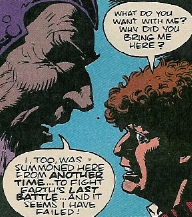 Doctor
Who
Doctor
WhoThe space-and-time-traveling adventurer known only as the Doctor, introduced in a BBC-TV television series in 1963, has long appeared in comics as well. He aided Arthur and Merlin in battle against the hordes of Catavolcus on a future Earth in "The Neutron Knights" (Doctor Who Magazine #60, Marvel UK, 1980; reprinted in Doctor Who #14, Marvel, 1985) and encountered Merlin again in the sequel, "The Tides of Time" (Doctor Who Magazine #61-67, Marvel UK, 1980; reprinted in Doctor Who #15-18, Marvel, 1985-1986).
Walt
Disney's famous anthropomorphic waterfowl had a significant Arthurian
adventure in writer-artist Don Rosa's 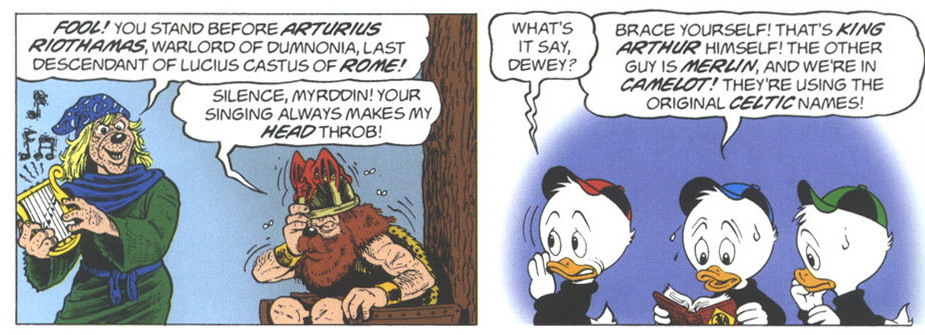 "The
Once and Future Duck", originally published in 1996 by the Danish
publisher Egmont, and subsequently reprinted in a variety of languages
and editions (including in Walt
Disney's Comics and Stories
#607-609 in the U.S.). In this 24-page tale, Rosa utilized the
familiar "Connecticut Yankee" device of sending Donald (accompanied by
his three nephews and the inventor Gyro Gearloose) back in time, but
instead of a splendid, shining city of Camelot, they found a wooden
hillfort commanded by a rough-mannered and ruthless Dark Ages warlord
named Arturius. (As indicated in the panels reproduced at left,
the inhabitants of this
"The
Once and Future Duck", originally published in 1996 by the Danish
publisher Egmont, and subsequently reprinted in a variety of languages
and editions (including in Walt
Disney's Comics and Stories
#607-609 in the U.S.). In this 24-page tale, Rosa utilized the
familiar "Connecticut Yankee" device of sending Donald (accompanied by
his three nephews and the inventor Gyro Gearloose) back in time, but
instead of a splendid, shining city of Camelot, they found a wooden
hillfort commanded by a rough-mannered and ruthless Dark Ages warlord
named Arturius. (As indicated in the panels reproduced at left,
the inhabitants of this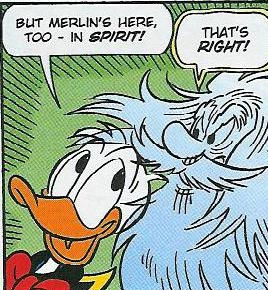 "Camallate" were neither ducks nor quite human, but rather the heavily
anthropomorphized dogs familiar to readers of Disney duck
comics.) The story's details evidence considerable authorial
research into the "historical Arthur", even to the extent of including
references to the somewhat controversial Alano-Sarmatian
hypothesis.
(As a side note, this story was adapted by Rosa from "Knighttime", an
earlier, never-completed story that appeared as part of his
black-and-white"Pertwillaby Papers" series; the published installments
of this version of the tale have themselves been reprinted in Don Rosa Archives, Vol. 1: The
Pertwillaby Papers and Don
Rosa Classics: The Complete Pertwillaby Papers.)
"Camallate" were neither ducks nor quite human, but rather the heavily
anthropomorphized dogs familiar to readers of Disney duck
comics.) The story's details evidence considerable authorial
research into the "historical Arthur", even to the extent of including
references to the somewhat controversial Alano-Sarmatian
hypothesis.
(As a side note, this story was adapted by Rosa from "Knighttime", an
earlier, never-completed story that appeared as part of his
black-and-white"Pertwillaby Papers" series; the published installments
of this version of the tale have themselves been reprinted in Don Rosa Archives, Vol. 1: The
Pertwillaby Papers and Don
Rosa Classics: The Complete Pertwillaby Papers.)
A very different approach to the Matter of Britain was taken in a story published (in the United States) in Walt Disney's Mickey Mouse Adventures #7 (Dec., 2005), when Donald, along with his lady duck friend Daisy, encountered the spirits of Morgan Le Fay (also a duck) and Merlin (a human this time, though as indicated by the illustration to the right, not much resembling the famous version in Disney's The Sword in the Stone).
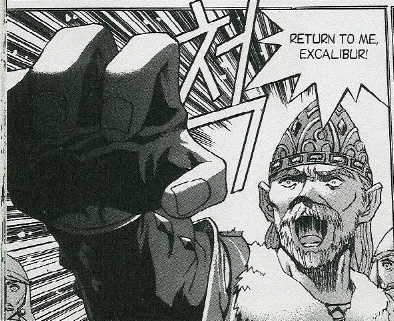
Although this fantasy manwha (Korean comic) series by Hong Seock Seo was primarily set in a legendary version of 6th Century Korea, the setting for one storyline, "The West," ranged as far as Camelot. Wandering dragon hunter Kok-Jung was enlisted by Merlin to hunt Siegfried's dragon, but the wizard turned out to have ulterior motives, and Kok-Jung and his companions had to face the power of both the dragon and Merlin when they both pursued Kok-Jung home to Korea. Other familiar Arthurian characters appeared in this story, including Arthur himself (pictured), as well as the original character of Riah, Arthur's illegitimate daughter, a warrior in her own right who wields an "astral version" of Excalibur. "The West" was originally published in South Korea in 2002, and was reprinted in English translation in 2005 by Tokyopop in volumes 9 - 11 of their Dragon Hunter series.
Merlin and Avalon were ongoing story elements in this super-team comic book series created by Bill Willingham (later to create Fables) and published sporadically through the 1980's and 1990's by Comico, beginning with the appearance of a boy wizard named Ambrose in Elementals v.1, #19. This wizard was eventually identified as Merlin Ambrose of Camelot, Regent of the realm of Avalon. In Elementals v. 2, #7, Ambrose changed his appearance into that of a handsome young man and wedded one of the team's members, Morningstar. In "The Sword In The Stone" (Morningstar Special #1, April, 1990), Morningstar visited the tomb of King Arthur in Avalon.
Jack Kirby, the creator of the Demon, also featured Arthurian elements in other series of his creation (see the entry for The Forever People below). The Eternals were an advanced, immortal branch of humanity who were the basis for various mortal myths and legends. In The Eternals #4 ( October, 1976), Sersi (Circe) described how she visited Camelot and showed Merlin a few new tricks.
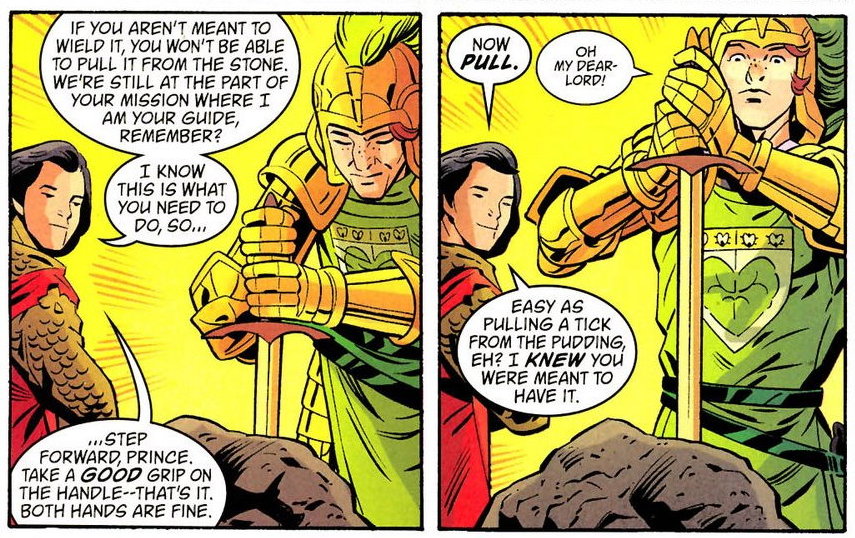 The premise of writer Bill Willingham's long-running Vertigo (DC)
series Fables
(2002-2015) -- that the characters of fairy tales, legends, and nursery
rhymes are
real, and that many are now living in our own mundane world, having
fled here from their Homelands to escape a powerful Adversary -- makes
the entire world of
folklore (and other public domain literature) available for the
author's use; and indeed, Arthurian elements have appeared sporadically
since the series' beginning, occasionally becoming
important to the
storylines. In early issues, a sword in a stone appeared in the
background in scenes set in the business office of Fabletown (the New
York City enclave of the folktale characters, or "Fables"), as did the
Forsworn Knight, a figure in full medieval body armor hanging by his
neck from a noose. Not until the story arc "The Good Prince"
(originally published in issues #60-63 and #65-69 of the monthly
series, and later reprinted in trade paperback) did readers learn than
the Forsworn Knight was in fact the ghost
of Lancelot, who had hung himself in remorse for having helped cause
the fall of Camelot through his illicit affair with Guinevere.
The premise of writer Bill Willingham's long-running Vertigo (DC)
series Fables
(2002-2015) -- that the characters of fairy tales, legends, and nursery
rhymes are
real, and that many are now living in our own mundane world, having
fled here from their Homelands to escape a powerful Adversary -- makes
the entire world of
folklore (and other public domain literature) available for the
author's use; and indeed, Arthurian elements have appeared sporadically
since the series' beginning, occasionally becoming
important to the
storylines. In early issues, a sword in a stone appeared in the
background in scenes set in the business office of Fabletown (the New
York City enclave of the folktale characters, or "Fables"), as did the
Forsworn Knight, a figure in full medieval body armor hanging by his
neck from a noose. Not until the story arc "The Good Prince"
(originally published in issues #60-63 and #65-69 of the monthly
series, and later reprinted in trade paperback) did readers learn than
the Forsworn Knight was in fact the ghost
of Lancelot, who had hung himself in remorse for having helped cause
the fall of Camelot through his illicit affair with Guinevere. 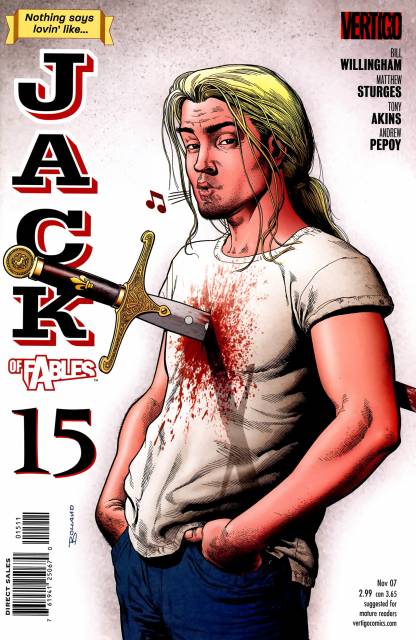 In this story, Lancelot came forward to assist Ambrose, the Frog
Prince, when the latter regained his memory after serving for years as
a janitor in Fabletown. Lancelot gave him his armor and led
Ambrose to pull the sword, Excalibur, from the stone, then knighted him
with it. Lancelot then joined Flycatcher on a quest to strike
against the Adversary and create a new peaceful kingdom in the
Homelands.
In this story, Lancelot came forward to assist Ambrose, the Frog
Prince, when the latter regained his memory after serving for years as
a janitor in Fabletown. Lancelot gave him his armor and led
Ambrose to pull the sword, Excalibur, from the stone, then knighted him
with it. Lancelot then joined Flycatcher on a quest to strike
against the Adversary and create a new peaceful kingdom in the
Homelands.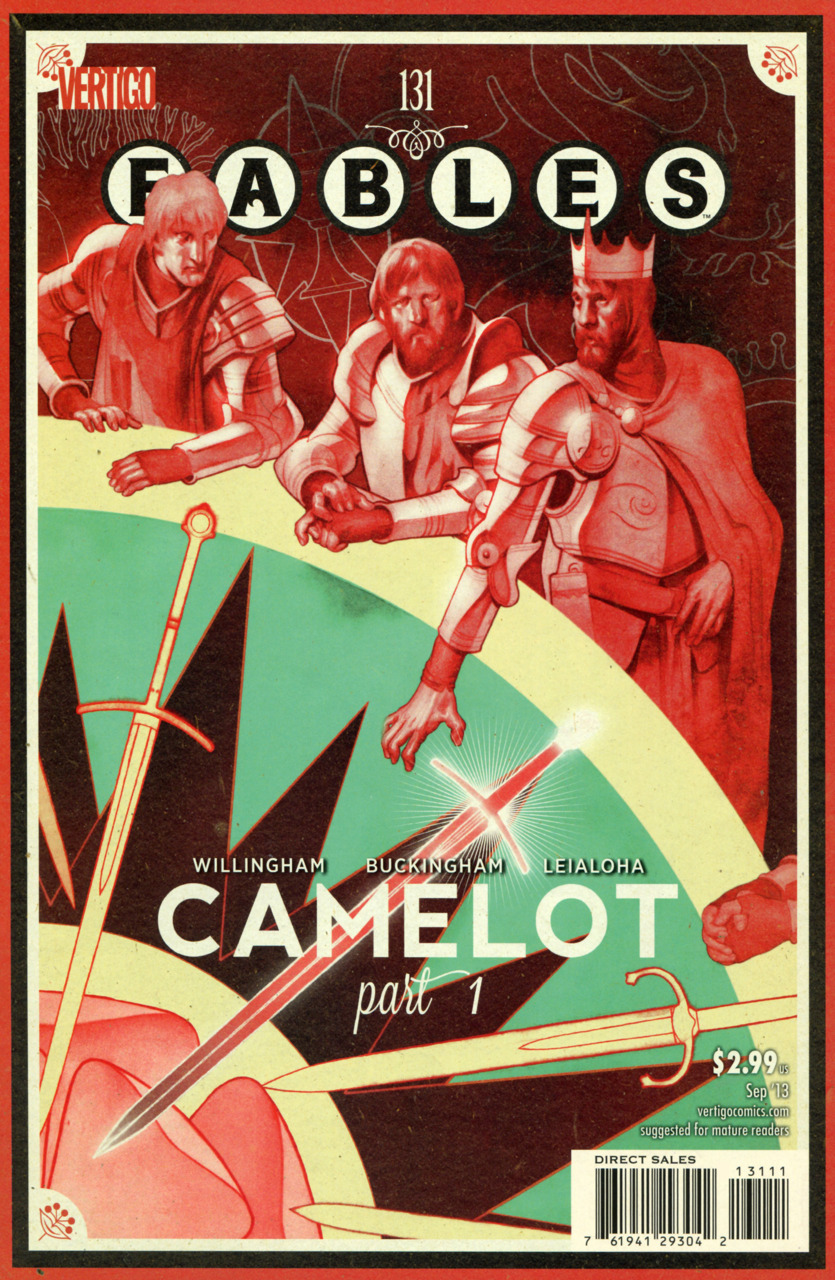 Lake
as a green-skinned woman who serves the Fates by assigning (and
reassigning) individual destinies, and "sometimes lives in
ponds". Both Morgan and Lake figured into a storyline beginning
in issue #131 in which one of the series' main characters, Rose Red,
decided to re-establish Camelot among the Fables in our contemporary
world. Lancelot also returned for this story, taking his place in
a new iteration of the familiar love triangle of Arthur, Guinevere, and
Lancelot (though Lancelot found himself this time taking the role of
Guinevere). Plot threads introduced in the "Camelot" story arc
played out over the latter few storylines of the series, reaching their
resolution only with the culmination of the final arc, perhaps
inevitably entitled "Happily Ever After". (All storylines in Fables and its related
series have been or soon will be collected in trade paperback.)
Lake
as a green-skinned woman who serves the Fates by assigning (and
reassigning) individual destinies, and "sometimes lives in
ponds". Both Morgan and Lake figured into a storyline beginning
in issue #131 in which one of the series' main characters, Rose Red,
decided to re-establish Camelot among the Fables in our contemporary
world. Lancelot also returned for this story, taking his place in
a new iteration of the familiar love triangle of Arthur, Guinevere, and
Lancelot (though Lancelot found himself this time taking the role of
Guinevere). Plot threads introduced in the "Camelot" story arc
played out over the latter few storylines of the series, reaching their
resolution only with the culmination of the final arc, perhaps
inevitably entitled "Happily Ever After". (All storylines in Fables and its related
series have been or soon will be collected in trade paperback.)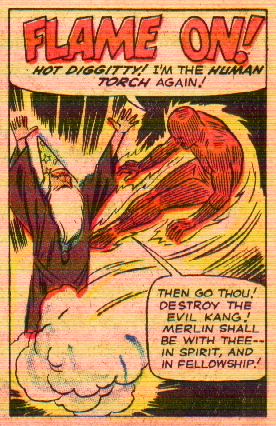
Marvel Comics' premiere superhero team had an early, quasi-Arthurian encounter when they visited Avalon (and met the non-Arthurian legendary figure Prester John) in Fantastic Four vol. 1, #54 (reprinted in hardcover in Marvel Masterworks: Fantastic Four #51-60, and in black-and-white trade paperback format in Essential Fantastic Four, Vol. 3. Two of the team members, the Thing and the Torch, battled the time-traveling villain Kang the Conqueror in Camelot in Strange Tales #134, encountering Merlin along the way (see illustration at left; story reprinted in black-and-white trade paperback format in Essential Human Torch). Much later, the team was at the center of the two-issue miniseries Fantastic Four: Atlantis Rising (June and July, 1995), which "crossed over" not only with their own series (vol. 1, #401 and 402), but with other Marvel series, including the spin-off title Fantastic Force (#9) and several issues of Namor, the Sub-Mariner. The complicated storyline involved Morgan Le Fay's raising of the sunken continent of Atlantis in attempt to restore her homeland of Avalon. (For more details, see the Namor entry.)
Jack Kirby created this series
about a group of
young gods from another world for DC Comics in the early 1970's. In
their seventh issue (Vol. 1, March, 1972; reprinted in
black-and-white paperback format in the collection Jack
Kirby's
The Forever People), the Forever People had been banished by
the
evil god Darkseid to various eras of Earth's past. The young god
called Big Bear found himself in Britain at the time of the Roman
army's departure, where he helped a rough warrior named Arta impress
his fellows (Gwane and Lanslac) with his leadership potential by
secretly assisting him to pull a sword out of a tree trunk. This is
one of American comics' rare attempts at a portrayal of the
"historical Arthur". (See also Donald Duck,
above.)
This one-time professional thief, a sometime
member of Marvel's X-Men team of mutant superheroes, was coerced into
stealing the sword Excalibur from its current bearer, Dr. Faiza Hussain (also known
as Excalibur) leading to a confict with the hero Excalibur and her
fellow MI:13 agents (including the Black Knight) in in Gambit
v. 5, #6-7 (2013).
The Disney animated television series Gargoyles, which originally aired from 1994 - 1997, related the adventures of a clan of living gargoyles, returned to life in modern New Your City after having been frozen in stone for a thousand years. Over the course of its run, an extensive background was developed for the series which incorporated various elements from mythology, legend, and history. King Arthur was brought back to life from an enchanted sleep in one episode, and recovered Excalibur in another. Following the TV series' cancellation, series creator Greg Weisman continued the storyline in comic books that were published by Slave Labor Graphics, beginning in 2006. A three-part story involving the gargoyles, King Arthur, and the Stone of Scone (here identified with the stone from which Arthur drew his sword) appeared in 2007 - 2009. The first two chapters were originally printed as issues #7 and 8 of the Gargoyles comics series; following the series' cancellation in 2008, these chapters were collected along with the unpublished third chapter in the trade paperback Gargoyles: Clan-Building, Volume Two, which appeared in August, 2009.
DC's "Emerald Archer," a
contemporary masked
crimefighter, met a carnival fortune teller named Merlin who later
turned out to be (probably) the genuine article in "The Curse of the
Wizard's Arrow!" (Adventure
Comics
#261, June, 1959). A few months later, Green Arrow and his boy sidekick
Speedy visited 6th Century Camelot in "The Green Arrow in King
Arthur's Court" (Adventure Comics #268, Jan., 1960),
in an adventure which may have been "real," or just a dream inspired by
Mark
Twain's A
Conneticut Yankee in King Arthur's Court.
(Both stories were reprinted in black
and white in Showcase
Presents Green Arrow, Vol. 1.) Many years later, in Green Arrow
v. 5, #1-14 (2010-2011), the emerald archer encountered a mysterious
armored figure who believed himself to be Sir Galahad. Although
ultimately turning out not to be the "real" Knight of the Round Table,
this present-day Galahad nevertheless proved himself a worthy bearer of the name in
a storyline that also featured Etrigan
the Demon.
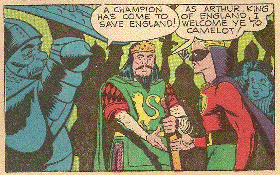
The first of several DC superheroes bearing the name of Green Lantern traveled through time for an Arthurian adventure in "Rumors of the Round Table"(All-American Comics#72, April 1946). The hero and his sidekick Doiby Dickles encountered Merlin (a friendly charlatan) and a "dragon" who was revealed to be Roger Bacon, experimenting with gunpowder.
John Constantine, a character
first introduced
in DC/Vertigo's Swamp
Thing, is a
chain-smoking,
trenchcoat-wearing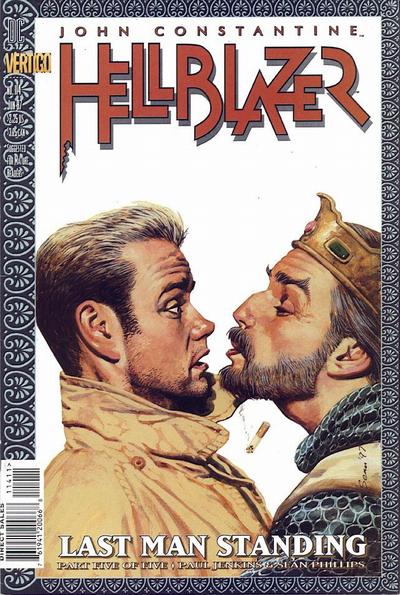 English sorcerer. In Hellblazer Annual #1 (1989),
writer Jamie
Delano told the story of the title character's (implied)
fifth-century ancestor, the Constantine traditionally depicted as
Arthur's successor as King of Britain. This Kon-sten-tyn was, like
Arthur, a pupil of Merlin, but unlike Arthur, developed magical
prowess and eventually surpassed, then imprisoned, and eventually
(apparently) destroyed Merlin. Kon-sten-tyn struggled all his long
life to resist the Christian suppression of the old pagan ways, and
by the end of his life, had achieved a secret victory.
English sorcerer. In Hellblazer Annual #1 (1989),
writer Jamie
Delano told the story of the title character's (implied)
fifth-century ancestor, the Constantine traditionally depicted as
Arthur's successor as King of Britain. This Kon-sten-tyn was, like
Arthur, a pupil of Merlin, but unlike Arthur, developed magical
prowess and eventually surpassed, then imprisoned, and eventually
(apparently) destroyed Merlin. Kon-sten-tyn struggled all his long
life to resist the Christian suppression of the old pagan ways, and
by the end of his life, had achieved a secret victory.
An altogether different interpretation of Arthurian legendary materials was offered by writer Paul Jenkins in the "Last Man Standing" storyline which ran in issues #110 - 114 of the regular Hellblazer series (Feb. - June, 1997). Here Merlin appeared as Mr. Meardon, who in league with government leaders had begun tearing down ancient mystical landmarks of Britain. Opposing him, Constantine encountered a group of Arthur's knights (based on the Welsh tradition of the Mabinogion, rather than on Malory) -- like Meardon (or Myrddin), remnants of an eternal race older than humankind. Constantine learned that Arthur himself had been a human granted eternal life by God, along with the secret of why God forsook Myrddin's race, his first children. Arthur had placed the knowledge into a box -- the Grail -- and disappeared. In the present day, Constantine's friend Rich the Punk was revealed as Arthur's heir and the achiever of the Grail, and Constantine outwitted Meardon at the last, effecting an ultimate reconciliation between Arthur and Myrddin.
These two "Hellblazer" stories, while very different, are both among the most original and provocative Arthurian stories that have appeared in American comics.
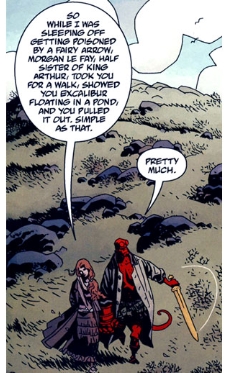
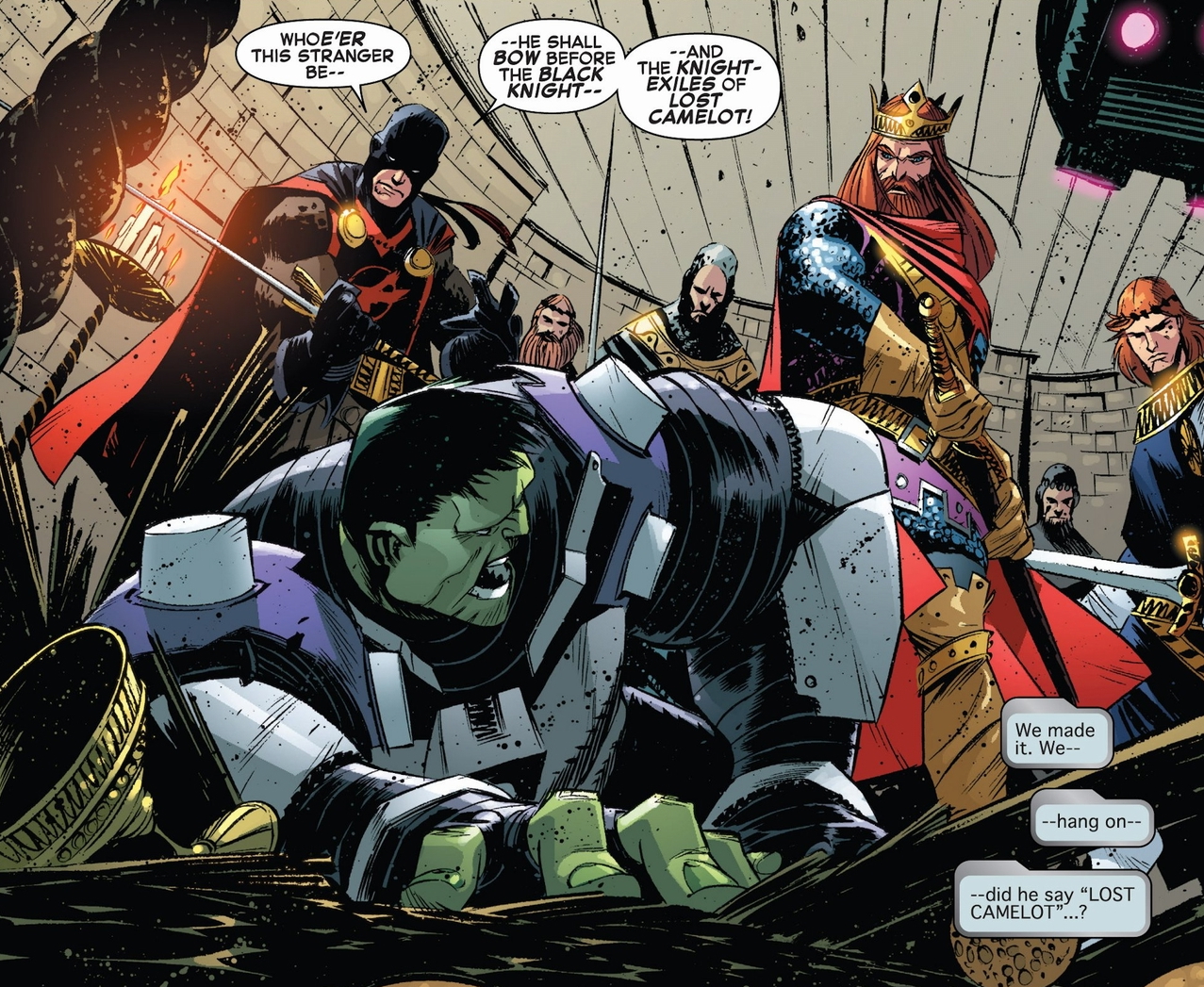
Fawcett Comics' sorcerous superhero followed his enemy Karnak through time to the court of King Arthur in Whiz Comics #142 (Feb., 1952)
Dark Horse Comics published Indiana Jones and the Spear of Destiny as a four-issue miniseries in 1995. The story is a sequel of sorts to the film Indiana Jones and the Last Crusade, and features Indiana and his father Dr. Henry Jones on a quest for the Spear of Longinus with extensive reference to the Grail lore associated with Glastonbury, England, as well as to the familiar premise of the Nazis' interest in mystical relics.
A Marvel superhero inspired by the martial-arts fad of the 1970's, Iron Fist was featured in numerous issues of the black-and-white magazine The Deadly Hands of Kung Fu as well as in his own color comic. In the third chapter of a six-part serial in the former publication (issue #21, Feb., 1976), Iron Fist encountered a mysterious character named the Bowman, who identified himself as a servant of the Firebird, the "mystic soul of Man." Iron Fist and the Bowman fought alongside one another in the following issue (#22), and in the serial's last chapter (#24) the Bowman revealed himself as Lancelot, seeking penance for his role in Camelot's end by serving the Firebird through eternity. This serial was written by Chris Claremont (co-creator of Captain Britain and Excalibur) and drawn by Rudy Nebres.
In the 1990's, Iron Fist became a teammate of the Black Knight in the short-lived Heroes for Hire series.
 Iron Man, a
member of the Avengers
who fights for the right in a suit of shining high-tech armor, has an
obvious affinity with the traditional Arthurian knight. To
commemorate his 150th issue (Sept., 1981), Marvel Comics had both
Iron Man and the armored supervillain Doctor Doom transported to the
time of Camelot. Doom quickly aligned himself with Morgan Le Fay,
while Iron Man came to the defense of King Arthur. Both hero and
villain returned to their proper time at the conclusion of this
memorable tale, to be reunited years later for a sequel in Iron
Man #250 (Dec., 1989). In this less-successful story, Doom
and
the armored Avenger were drawn to the year 2093, where Merlin and a
child Arthur had reappeared in Britain's time of greatest need. (Both
stories were reprinted in a single trade paperback volume, Iron
Man vs. Dr. Doom.) Marvel also published another sequel to
Iron
Man's original Camelot adventure in What If? #33.
This story
provided an "alternate history" in which Iron Man remained trapped in
Arthur's time and became king following Arthur's death at the hands
of Mordred. (Years later, yet another alternate history of Dr. Doom's
exploits in Camelot was published in What If
v.2, #97;
this story centered on a version of the Black
Knight, rather than Iron Man.)
Iron Man, a
member of the Avengers
who fights for the right in a suit of shining high-tech armor, has an
obvious affinity with the traditional Arthurian knight. To
commemorate his 150th issue (Sept., 1981), Marvel Comics had both
Iron Man and the armored supervillain Doctor Doom transported to the
time of Camelot. Doom quickly aligned himself with Morgan Le Fay,
while Iron Man came to the defense of King Arthur. Both hero and
villain returned to their proper time at the conclusion of this
memorable tale, to be reunited years later for a sequel in Iron
Man #250 (Dec., 1989). In this less-successful story, Doom
and
the armored Avenger were drawn to the year 2093, where Merlin and a
child Arthur had reappeared in Britain's time of greatest need. (Both
stories were reprinted in a single trade paperback volume, Iron
Man vs. Dr. Doom.) Marvel also published another sequel to
Iron
Man's original Camelot adventure in What If? #33.
This story
provided an "alternate history" in which Iron Man remained trapped in
Arthur's time and became king following Arthur's death at the hands
of Mordred. (Years later, yet another alternate history of Dr. Doom's
exploits in Camelot was published in What If
v.2, #97;
this story centered on a version of the Black
Knight, rather than Iron Man.)
Iron Man also crossed paths with Morgan Le Fay in the present day in #209 (Aug., 1986). In this story, following her attempts to re-enter the mortal world through Spider-Woman, Morgan's spirit temporarily possessed the sister of Jack Russell, the "Werewolf By Night", having been drawn by the Russell family's connection to the Darkhold. Iron Man also joined the Knights of Pendragon in several of their adventures, and was summoned by the Lady of the Lake to aid the super-team Excalibur against Dr. Doom.
In 2008, Marvel published yet another sequel to the original Iron Man - Doctor Doom Arthurian adventure. Billed as the conclusion of the "Camelot Trilogy", this four-issue miniseries (later reprinted in both hardcover and trade paperback) was entitled Iron Man: Legacy of Doom, and featured the two armored characters in a modern-day battle over the sword Excalibur that also involved Merlin and Morgan Le Fay.
According to the Arthurian Annals, "Superman's pal" Jimmy Olsen drank a potion concocted by Merlin and was transformed into "The Wolf-Man of Metropolis" in Jimmy Olsen #44 (National Periodical Publications/DC Comics, April, 1960). According to the same source, as well as DarkMark's Superman index, Jimmy had an even more Arthurian adventure a few issues later when, while attending a costume ball as a knight, he was sent back to King Arthur's time by the fifth-dimensional imp Mr. Mxyzptlk, and encountered Merlin himself (another imp), as well as Arthur, Guinevere, and several Knights of the Round Table (issue #53, June,1961).
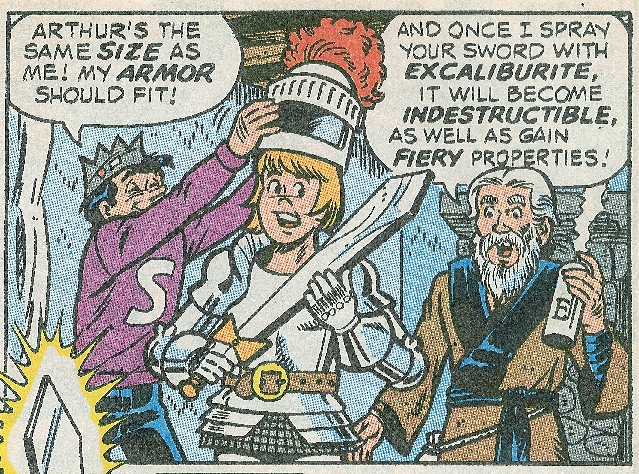
Archie Comics' beanie-wearing, food-loving teenager, Jughead Jones, dreamed he was Sir Jugalot, a knight of Camelot, in Jughead's Fantasy #1 (Aug., 1960). (Source: Arthurian Annals.) Thirty years later, as a member of the Time Police -- an organization dedicated to preserving the integrity of history -- Jughead traveled to the Arthurian era in pursuit of a rogue Time Police agent, Morgan Le Fay, in Jughead's Time Police #2 (Sept., 1990). In the course of the adventure, Jughead encountered the founder of the Time Police, Merlin, who had retired to the Middle Ages, and Merlin's apprentice Arthur. In the course of thwarting Le Fay, Jughead and his fellow agents helped Arthur ascend to the throne. Morgan returned for another appearance in issue 6 (May, 1991).
In 2001, DC Comics began publishing a series in which major DC superheroes were reimagined by Stan Lee, one of the major architects of Marvel Comics' superheroic fantasy universe in the 1960's. In 2002, the Captain Marvel character concept was reworked in Just Imagine Stan Lee With Gary Frank Creating Shazam. Both Merlin and Morgan Le Fay appeared in this comic; Merlin, who had survived to the 21st Century in the guise of an Indian fakir, perished during the course of the story, but Morgan survived to join forces with the series' ongoing villain, Dominic Darrk. She appeared in the next chapters, but ultimately met her demise in the concluding chapter, Just Imagine Stan Lee With John Cassaday Creating Crisis. (The series was reprinted in three trade paerback volumes entitled Just Imagine Stan Lee Creating the DC Universe, with the Arthurian characters appearing in the second and third volumes.)
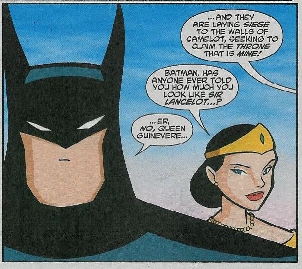
DC's premiere super-team met a
Merlin from a
Camelot in another dimension, known as Magic-Land, in "Secret of the
Sinister Sorcerers." (Justice League of America v.1,
#2, 1960;
reprinted in hardcover in Justice League of America Archives,
Vol.
1 and in the black and white paperback Showcase
Presents
Justice League of America, Vol. 1.). Justice
League Europe Annual #2 (1991) presented a light-hearted tale
of
an alternate future in which the members of the European branch of
the team were displaced through different time periods. In one 4-page
chapter the Russian superhero Rocket Red was deposited in Camelot,
where he encountered Arthur, Merlin, and Etrigan
the Demon. In
the 9th issue of
Justice League Unlimited (2001), members of the team
accompanied the Shining
Knight
on a
journey through time to
defend Camelot from Morgaine Le Fey, meeting Arthur, Merlin,
Lancelot, and Guinevere (see illustration at right). Yet
another
tale of time displacement appeared in 2009's Justice League of
America
80 Page Giant; this story found the heroes Vixen and Green
Lantern
transported to Camelot, where they aided the Shining
Knight against
Morgaine in a familiar scenario, once again played for humor. The current series Justice League 3000 (2013-2015: to be succeeded by Justice League 3001 beginning later in 2015), which features imperfect replicas of Superman, Batman, Wonder Woman,
and others abruptly brought to life in the 30th Century, takes a
different approach in its use of Arthurian legend; here, Arthur,
Guinevere, Merlin, and the Knights of the Round Table dwell on a planet
called Camelot-Nine, where they are fighting a war against the infernal
forces of Etrigan. (The storyline is ongoing as of this writing,
and the true nature of Camelot-Nine and its denizens has yet to be
revealed.)
The Quality Comics superhero Kid Eternity was a boy who could summon the spirits of heroes of past eras and could travel through time. In Hit Comics # 32 (Summer, 1944), Kid Eternity battled Merlin for Excalibur in a story which also featured King Arthur, the Lady of the Lake, and the superhero Plastic Man. (Sources: the Grand Comics Database, the Arthurian Annals, and The Photo-Journal Guide to Comic Books.)
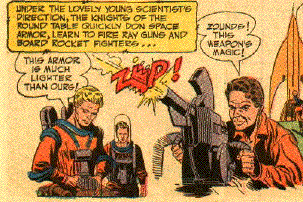 The
Knights of the Galaxy are a space-faring band of crimebusters whose
adventures, set in the future, were published by DC Comics in the
1950's. In Mystery In Space #8 (June/July, 1952), a
spell cast
by an evil Merlin temporarily transposed the Galaxy Knights' minds
with those of their counterparts of the Round Table centuries
earlier. (Interestingly, when DC reprinted this story 18 years later in Justice League of America v.1, #85, the story was revised to give Merlin's villainous role to a more traditional enemy, Morgan Le Fay. Credit to Morgan expert Robert Glasel for alerting me to the discrepancy between the two versions.)
The
Knights of the Galaxy are a space-faring band of crimebusters whose
adventures, set in the future, were published by DC Comics in the
1950's. In Mystery In Space #8 (June/July, 1952), a
spell cast
by an evil Merlin temporarily transposed the Galaxy Knights' minds
with those of their counterparts of the Round Table centuries
earlier. (Interestingly, when DC reprinted this story 18 years later in Justice League of America v.1, #85, the story was revised to give Merlin's villainous role to a more traditional enemy, Morgan Le Fay. Credit to Morgan expert Robert Glasel for alerting me to the discrepancy between the two versions.)
The hell-goddess "bad girl" character created by Brian Pulido and
Steven Hughes in 1991 has appeared in a number of versions from a
variety of publishers since her debut in 1991. Lady Death: Re-Imagined
(Chaos! Comics, 2002) presented a version who began as Faith, the
daughter of a Grand Inquisitor in 13th century Burgundy. When her
father sought to gain immortality and power by stealing the Holy Grail
from a group of Knights Templar, Faith attempted to stop him by seizing
the Grail first and drinking from it. However, the Templars'
leader had placed a curse on the Grail in an effort to thwart the
Inquisitor's aims, and so Faith became Lady Death -- immortal and
powerful, but soulless as well -- whose first act was to slay her
father.
Martin Mystere is an unusual
detective, created
by Alfredo Castelli in 1978 for Italy's Bonelli Comics line, who
investigates
mysteries involving ancient civilizations, UFOs, secret societies,
and a variety of strange phenomena. Several of his adventures have
involved the Holy Grail, according to Mariano Tomatis'
"The
Holy Grail" web site.
In another
adventure, "The Sword of King Arthur" (scripted by Castelli, and
reprinted in English in 1999 by Dark Horse Comics in Martin
Mystery #3 and 4), Martin found the sword Excalibur and
traveled
through Europe on a quest to uncover its secrets with his ruthless
nemesis, Orloff, in pursuit. Eventually, at Stonehenge, the detective
learned the truth behind the Arthurian legends, which turned out to
involve an ancient and lost technology as well as a long-ago visit to
Earth by unfriendly aliens.
According to the Arthurian Annals, the original Captain Marvel and the other members of the Marvel Family discovered King Arthur's Round Table in The Marvel Family #8 (Fawcett, Feb., 1947). Much more recently, in the 12-issue miniseries The Trials of Shazam (DC Comics, 2006-2008), Freddy Freeman, the former Captain Marvel, Jr., competed for the right to inherit the powers of the wizard Shazam against Sabina, the representative of a group called the Council of Merlin. Merlin himself appeared in the series' final issue, portrayed as a demonic figure complete with horns.
The Sub-Mariner, one of Marvel Comics' oldest superheroes, is the son of an American naval officer and a princess of the undersea civilization of Atlantis. The final three issues of Namor, the Sub-Mariner (#60 - 62, March - May, 1995) served as a prelude to the Fantastic Four: Atlantis Rising miniseries. Namor battled Morgan Le Fay (last seen in the Black Knight's 1990 miniseries) and learned the secret history of Atlantis and Avalon; when the continent of Atlantis had sunk beneath the ocean, several islands survived, including Avalon. Both Morgan and Merlin were natives of Avalon who fled to Britain before it, too, finally sank. (Namor also encountered the spirit of the first Black Knight in these issues.)
For the Arthurian adventures of another Atlantean superhero,
see
the entry for Aquaman.
This short-lived super-team series from Eclipse Comics included a young sorceress code-named Avalon among its main characters. In issues #7 - 9 (Sept. - Oct., 1986), readers learned that Avalon, or Elizabeth, was actually the daughter of a priestess from the enchanted island of Avalon. Morgana, the Lady of Avalon, summoned Elizabeth home, and the rest of the team journeyed there to retrieve her. The story (written by Mindy Newell) appeared to have been considerably influenced by Marion Zimmer Bradley's novel, The Mists of Avalon.
This short-lived Marvel Comics series (Dec., 2005 - May, 2006), which took its name from the better-known World War II-based series Sgt. Fury and his Howling Commandos, featured a unit within the contemporary superspy organization S.H.I.E.L.D. which was composed entirely of monsters and other supernatural entities. In a storyline that spanned all six issues of the series' run, Merlin escaped from a S.H.I.E.L.D. containment facility in the United States and traveled to Great Britain, transforming it into an otherworldly medieval realm, which he ruled until defeated by the Howling Commandos.
Comics illustrator-storyteller
Dave Dorman
introduced some of the concepts that would become part of the world
of "The Wasted Lands" in the comics anthology A1
(v.2, #4,
Marvel/Epic Comics, 1992). In Dorman's eight-page story "The Edge",
an adventurer traveled by motorcycle through a dystopian,
railroad-dominated desert land to claim a fragment of the stone that
once held Excalibur. In subsequent years Dorman slowly added to his
mythos, introducing new characters and concepts through trading-card
paintings and short stories (illustrated by Dorman, scripted by Del
Stone, Jr.). In 2001, Image Comics published Rail: Broken
Things,
in which Dorman and Stone told the story of how Edgar
Wallace, the Edge, first encountered the Lady of the Lake and received
both the sword Excalibur and a quest. The Edge was charged to recover
all the fragments of Excalibur's stone and reconstruct it so that
"the one true king' would be revealed when he once again drew the
sword from the stone. Both stories, along with Dorman and Stone's
other, non-Arthurian material set in the same world, were reprinted in
hardcover as Dave Dorman's Wasted Lands (Magnetic Press, 2014).
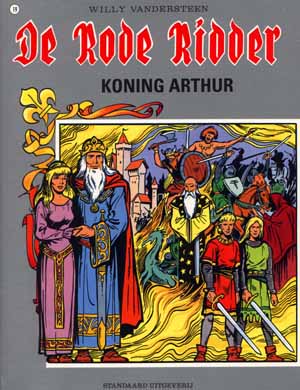
Belgian (Dutch language).
The Red Knight appears in a long-running series of graphic albums in Europe; as Robert Vermaat writes: "De Rode Ridder is a mega-opus by Willy Vandersteen, with the first album appearing in 1959 and still going strong, even when Vandersteen died a few years ago. Johan, the Red Knight, is a knight from an unspecified period in time, dealing with adversaries and monsters all over the world and of all ages. Chinese, UFO's, you name it. Of the 150+ albums, only a few relate adventures concerning King Arthur, Merlin or one of the Knights of the Round Table." Like Prince Valiant, the Shining Knight, or the original Black Knight, the Red Knight qualifies as a "new" Knight of the Round Table, though neither his origin story nor the majority of his subsequent adventures are Arthurian.
The series' Arthurian content may be divided into four sequences. "The best of these was produced during the middle sixties, starting with 'Koning Arthur' (#19) in 1964 and ending in 1965. The second series (#42-51) was drawn by Karel Biddeloo, starting in 1969 with 'Het Testament' ('The Will') and ending with 'Excalibur' in 1971. Twenty years later (1994), Johan returned to the Arthurian "period" with adventures set in Lyonesse, Avalon and Atlantis, where the heroes went after their defeat at Camlann. These later albums (#152-157) also by Karel Biddeloo, are not even close to the standard of the earlier ones... A fourth "part"... started with... #174 -- 'De Erfgenaam' ('The Heir'), in which Johan supports Lancelot against the murderer of King Ban, Lancelot's father. Merlin, Arthur and Guinevere have returned from their stay in Avalon as well, so it appears, which makes the series altogether timeless." Karel Bidderloo continued as writer and artist until his death in 2004. He was replaced by the team of Martin Lodewijk (writer) and Claus D. Scholtz (artist). (Additional sources: E-mail from Theodoor Westerhof and "De Rode Ridder" entry in Wikipedia.)
Also on the Web:
Marvel Comics' Rom series, based on a Parker Brothers toy, chronicled the adventures of an armored alien "Spaceknight" who had come to Earth to battle the equally-alien but malicious Dire Wraiths. In issue #37 (Dec., 1982), Rom was struggling to rescue children held captive by Dire Wraiths in a castle that had once belonged to Morgan Le Fay, when a spectral King and his band of knights (unnamed, but implied to be Arthur and the Knights of the Round Table) came to his aid.
In 2000, Marvel debuted Spaceknights, a series featuring Rom's sons Balin and Tristan (both names of Round Table Knights).
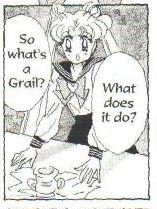
Sailor Moon is a Japanese teenage super-heroine whose adventures have been released more-or-less simultaneously in both anime (animated cartoon) and manga (comic book) format. The Holy Grail appeared in the third season or series (known as "Sailor Moon S") as a mystical talisman which granted Sailor Moon additional powers. This storyline, which originally appeared in Japan in 1994, was also published in English translation in a monthly series from Tokyopop Press, beginning with issue #24. (Additional source: The Sailor Moon Story web page.)
Slaine is a Celtic barbarian
hero created for
the British comic magazine 2000 AD by Pat Mills and
Angela
Kincaid.
In a
story arc written by Mills and painted by Dermot Power, Slaine was
brought through time by Morgaine and Merlin following the battle of
Camlann to search for the lost Treasures of Britain and bring them to
the undying Arthur in Avalon (pictured here). Once the Treasures had
been restored, Arthur could, in Morgaine's words, "become the once
and future king and heal the land!" As Slaine quested for the
Treasures, flashbacks related the story of Arthur and his
kingdom.
Mills and Dermot's work is a highly original (though violent) interpretation of the legend, drawing heavily on Welsh sources, and offering a unique interpretation of Guinevere as a sinister but tormented figure. The story was originally published in 2000 AD in 1996-1997 and has been reprinted in trade paperback as Slaine: Treasures of Britain.
A subsequent adventure of Slaine, set in southern France in the
1200's, found the time-traveling hero questing for the Grail Stone in the company of Simon de Montfort, leader of the Albigensien Crusade against the Cathars.
This storyline, written by Mills and painted by Steve Tappin, draws
liberally from modern ideas about a historical connection between the
Cathars and the Grail legends, as well as from Wolfram von Eschenbach's
German poem Parzival;
at the same time, it retains the influence of Celtic paganism (or, more
accurately, contemporary notions of such). The story originally
appeared in 1997-1998 and has been reprinted in trade paperback as Slaine: The Grail War.
This obscure feature about a villainous sorceress ran in all twenty issues of Fox Features' Weird Comics in the early 1940's. The Sorceress' encounter with Gareth, Merlin, Morgana Le Fay, Mordred, and one of the several Arthurian women named Elaine is related in "The Sorceresses of Camelot" (Weird Comics #7, Oct., 1940). (Source: the Grand Comics Database.)
Todd McFarlane's Spawn, published by Image Comics since 1992, tells the story of a man who makes a deal with a devil and becomes both a Hellspawn, destined to be a soldier in Hell's war against Heaven, and a superheroic champion. Issue #9 introduced Count Cogliostro (apparently based on the historical charlatan Alessandro, conte di Cagliostro), a mysterious old man who attempted to counsel Spawn. Cogliostro was eventually revealed to be an immortal Hellspawn himself, who had foresworn the cause of Hell. In the second issue of the spin-off series Spawn: The Dark Ages (April, 1999), Cogliostro introduced himself to a Hellspawn of medieval England, stating that he had been called many names in his time: "... Merridyn... Merlin... Prospero... Cogliostro..."
The first of several heroines to bear the name Spider-Woman, this character's early exploits were published by Marvel from 1978 to 1983 in an eponymously-titled series. Spider-Woman (Jessica Drew) had been raised on Wundagore Mountain in Europe, where centuries earlier the Elder God Chthon had been imprisoned by Morgan Le Fay and her minions. Jessica had been touched by the power of Chthon and the sorcerous book called the Darkhold, thus making her a target for Morgan in the present day. Spider-Woman fought several battles with Morgan, beginning in Spider-Woman vol.1, #2. Probably the most memorable encounter appeared in #41, "Le Morte de Jessica" (Dec., 1981), in which Jessica temporarily found herself living Morgan's life in Camelot. The conflict appeared to reach its culmination in issue #50, the series' final issue, in which Jessica Drew apparently died -- although her conflict with Morgan would actually be resolved on a more positive note some months later with the aid of the Avengers.
Starslayer, written and drawn by Mike Grell, presents the story of Torin Mac Quillon, a Celtic warrior drawn through time from the Roman invasion of Britain to help save Earth in the far future. The first issue (Pacific Comics, Feb., 1982), set prior to Torin's temporal journey, features his encounter with the "Druid necromancer" Ambrosius, who prophesies that though the Romans may conquer Britain, "the dragon shall rise again," and who then sets a sword through a stone and anvil to wait for a future king.
Merlin appears in several issues of this short-lived super-team series from Caliber, beginning with issue #2 (Dec., 1998). In this series, Merlin is a Time Lord who is banished to Dark Age Britain by his fellow Time Lords. Merlin encounters members of the StormQuest team in the 27th century as well as in medieval times. The story was reprinted in black-and-whte in the Stormquest: Timestorm trade paperback in 2002. (See also Blood & Roses.)
This comic book about a clandestine superhero team made its debut in 1993
as an Image Comics publication, but moved to DC Comics some years
later. In 2011 , Stormwatch was woven into DC's freshly rebooted fictional
continuity, "The New 52",
and given a new history and origin. This new version of the team was
led by an immortal named Adam One, eventually revealed to be
Merlin. Readers ultimately learned that the origins of the
Stormwatch team lay in the Middle Ages, with the adventurers known as
the Demon Knights. Stormwatch
v.3, #0 chronicled Merlin's assemblage of various versions of
Stormwatch over the centuries, and a 19th-century version featuring
Adam One appeared in a back-up feature in All-Star Western v.3, #17-21. Adam One was apparently killed in Stormwatch
v.3, #5, but later issues revealed his translation onto another plane
of existence by his other-dimensional masters, the Shadow Cabinet.
Among the adventures of Superman when he was a boy was "The Three Ages of Superboy" (Superboy #103, March, 1963) in which the Boy of Steel follows three stray Red Kryptonite meteors into past eras and has an adventure in the age of King Arthur in which he meets both Arthur and Merlin (in the guise of a Black Knight). Superboy's super-dog Krypto also had an Arthurian adventure, in issue #75."How Krypto Made History" described the alien canine's quest through time for good-tasting dinosaur bones, inadverdently affecting on the way such "historical" events as Arthur's pulling the sword from the stone. (Source: DarkMark's Superboy index.)
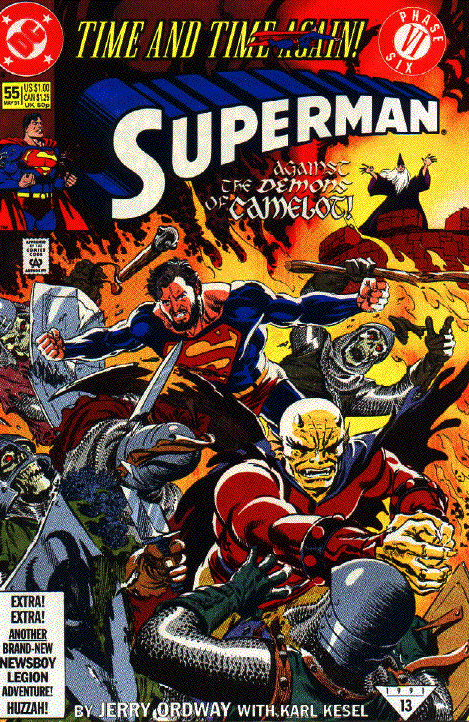
In Superman v.2, #55 (May, 1991; reprinted in trade paperback in Superman: Time and Time Again), a time-lost Superman appeared at Camelot during Morgaine Le Fey's final assault on Camelot (as originally portrayed in The Demon vol. 1, #1) and was temporarily bewitched into Morgaine's service before being restored to his right mind by Merlin. Etrigan the Demon also appeared in this story, which conflicts with some other accounts of Jason Blood's origins.
An "Elseworlds" story, Superman: Kal (1995), presented a scenario in which the infant Kal-El (Superman) arrived on Earth in the Dark Ages. Merlin appeared in the framing sequence of this story as the young apprentice of Kal's friend, Master Jamie Ollson (Jimmy Olsen), and the story also offered an extraterrestrial origin for the "sword in the stone."
In earlier stories, Superman visited Camelot in a dream in Superman v.1, #38 (Jan./Feb., 1946), and also traveled there in a sequence in his newspaper comic strip in 1949. (Source: The Arthurian Annals.) The character also traveled to the time of Camelot with Batman in World's Finest #162, and accompanied the Justice Society of America and the Shining Knight on a similar jaunt in All-Star Comics v.1, #48-49.
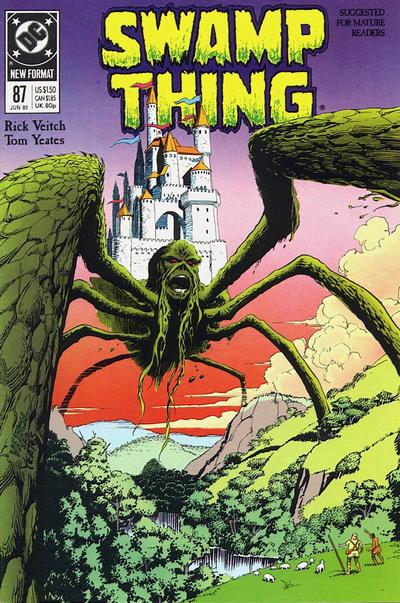
The Swamp Thing, an elemental spirit of the plant world, was unwillingly sent on a journey through time which, in "Fall of the House of Pendragon" (Swamp Thing #87, DC Comics, June, 1989) brought him to Camelot. Queen Guinevere, Merlin, Morgaine, Modred, and a wounded and mentally ill King Arthur all appeared in this downbeat but memorable story, in which Swamp Thing inadvertently hastened Camelot's fall. DC's Arthurian characters Etrigan the Demon and the Shining Knight also had roles in this tale.
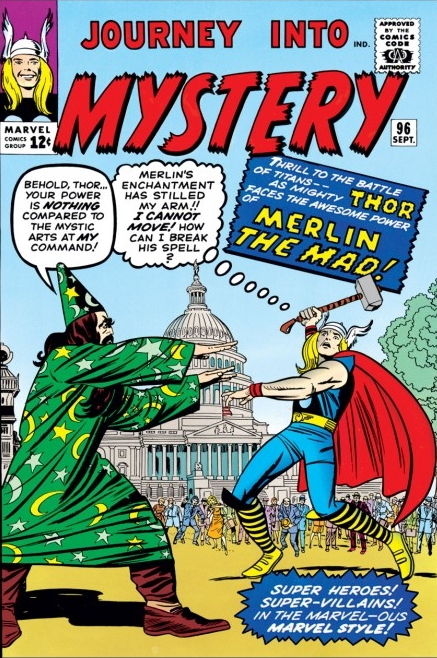 The
Mighty
Thor, Marvel Comics' version of the Norse God of Thunder, battled
"The Mad Merlin" in an early adventure published in Journey
Into
Mystery #96 (1963; reprinted in hardcover in Marvel
Masterworks: The
Mighty Thor, Vol. 1, and in black & white paperback
format in
Essential Thor). This Merlin was eventually revealed
in later
stories to be a mutant, the Maha Yogi, who had impersonated the true
Merlin. Many years later, in Free
Comic Book Day 2011 (Thor The Mighty Avenger),
Thor and his fellow Avenger Captain America traveled through time to
Camelot to rescue the real Merlin (who this time was being impersonated
by Thor's scheming brother Loki), meeting King Arthur and Sir Gawain
along the way.
The
Mighty
Thor, Marvel Comics' version of the Norse God of Thunder, battled
"The Mad Merlin" in an early adventure published in Journey
Into
Mystery #96 (1963; reprinted in hardcover in Marvel
Masterworks: The
Mighty Thor, Vol. 1, and in black & white paperback
format in
Essential Thor). This Merlin was eventually revealed
in later
stories to be a mutant, the Maha Yogi, who had impersonated the true
Merlin. Many years later, in Free
Comic Book Day 2011 (Thor The Mighty Avenger),
Thor and his fellow Avenger Captain America traveled through time to
Camelot to rescue the real Merlin (who this time was being impersonated
by Thor's scheming brother Loki), meeting King Arthur and Sir Gawain
along the way.
In 2012, King Arthur and Merlin turned up in issues #639-641 of Journey Into Mystery (at
that time a companion series to the main Thor title, starring
Loki), as the lords and defenders of Otherworld (including Captain Britain)
sought the aid of the Norse pantheon against an insurgency by a divine
manifestation of modern British industrialism, the "Manchester gods".
Thor has also encoutered Arthurian characters in group adventures with the Avengers over the decades, as well as in the Fantastic Four: Atlantis Attacks crossover.
DC Comics' time-traveling adventurer Rip Hunter battled a centuries-long conspiracy of the Illuminati in the 1990 miniseries Time Masters. In issue #5, Hunter sent an ally to 10th century Europe to help another DC hero, the Viking Prince, steal the Holy Grail from the Illuminati leader, Vandal Savage.
The popular video game "Tomb Raider" has been adapted for comics in a number of titles from Image Comics. Tomb Raider #5 and 6 (2000; reprinted in the trade paperback collection Tomb Raider, Volume 2: Mystic Artifacts, and in the U.K. in Tomb Raider: The Merlin Stone) relate Lara Croft's adventure involving a mystic portal into the time of the dinosaurs. The portal turns out to be associated with the Merlin Stone, a magical artifact with which Merlin could see through time and which Morgan LeFay has been searching for for centuries. In issue #6, Morgan (who has been masquerading as an archaeology student) attempts to seize the stone. A later story, published as Tomb Raider #1/2 (2001), reveals that Lara has also searched for and acquired King Arthur's crown.
Lara Croft also appears in the Dark Crossings miniseries which introduces the Butcher Knight.
The working-class patriotic British superhero (and one-time Knight of Pendragon) attempted to stop a band of vampires from seizing the Holy Grail in Marvel's 1998 - 1999 three-issue Union Jack miniseries (collected in trade paperback in 2002), written by Ben Raab and illustrated by John Cassaday.
According to Michael Torregrossa's "Camelot 3000 and Beyond", Merlin appears in two flashbacks within the pages of Vampire Bayne, Lord of the Night vol. 2, #1 (1996).
Antarctic Press' Warrior Nun Brigantia (2000) is a three-issue miniseries derived from the publisher's ongoing Warrior Nun Areala series. In 1940, the head of the ancient king Bran the Blessed has been stolen from Britain by Fata Morgana (Morgan le Fay) and delivered to Nazi Germany. Since legend says that Britain cannot be invaded only so long as Bran's head remains there, the British government calls on Brigantia to recover the head. Meanwhile, a warrior nun from the time of Camelot awakens to join the battle -- Arthur's own sister Anna, the White Nun. This series includes some interesting ideas, but the execution is disappointing.
This Image Comics series chronicles the adventures of Sara Pezzini, a New York police detective who possesses the "Witchblade", an ancient mystic weapon which can only be wieled by a female warrior. Witchblade #50 revealed that the Witchblade has a "male" counterpart, Excalibur, which came to be possessed by Sara's sometime ally, Ian Nottingham. Sara Pezzini also appeared in the Dark Crossings miniseries which introduced the Butcher Knight.
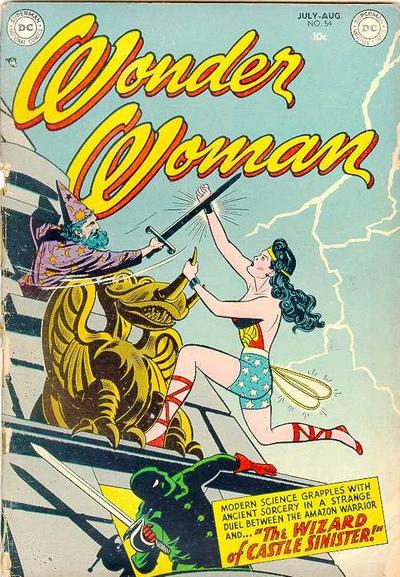 Diana, the super-powered
Amazon princess from
Paradise Island, time-traveled to Camelot and helped King Arthur
defeat the evil Merlin and rescue Queen Guinevere in Wonder
Woman #54, according to Mikel Midnight's Earth-2
Timeline. Later,
in issue #184
(September-October, 1969), Diana visited another dimension to seek
the aid of Arthur and other legendary heroes (including Siegfried and
Roland) against the army of the God of War, Mars. Also, as described
in Part
Three, Wonder
Woman has been involved
in Arthurian adventures with the
Demon,
where Morgaine Le Fey has been her primary adversary. Diana's
adversarial relationship with Morgaine was recently revisited in the 52
issues of DC Comics' weekly series
Trinity, which also starred Superman
and Batman.
Diana, the super-powered
Amazon princess from
Paradise Island, time-traveled to Camelot and helped King Arthur
defeat the evil Merlin and rescue Queen Guinevere in Wonder
Woman #54, according to Mikel Midnight's Earth-2
Timeline. Later,
in issue #184
(September-October, 1969), Diana visited another dimension to seek
the aid of Arthur and other legendary heroes (including Siegfried and
Roland) against the army of the God of War, Mars. Also, as described
in Part
Three, Wonder
Woman has been involved
in Arthurian adventures with the
Demon,
where Morgaine Le Fey has been her primary adversary. Diana's
adversarial relationship with Morgaine was recently revisited in the 52
issues of DC Comics' weekly series
Trinity, which also starred Superman
and Batman.
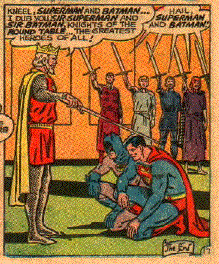 In
the story "Pawns of the Jousting Master" (issue #162, National
Periodical Publications/DC Comics, November, 1966), Superman
and Batman
were drawn back in time to assist the heroes of Camelot against an
invasion by aliens from outer space (some sixteen years before
Camelot
3000). The
knights of the Round Table
were presented as a medieval superhero group, with Arthur's
invincible sword Excalibur and Gawain's strength increasing towards
noon being joined by other, less traditional "super-powers" including
invulnerable armor for Lancelot, a cloak of invisibility for Kay, and
a flame-emitting ring for Bors.
In
the story "Pawns of the Jousting Master" (issue #162, National
Periodical Publications/DC Comics, November, 1966), Superman
and Batman
were drawn back in time to assist the heroes of Camelot against an
invasion by aliens from outer space (some sixteen years before
Camelot
3000). The
knights of the Round Table
were presented as a medieval superhero group, with Arthur's
invincible sword Excalibur and Gawain's strength increasing towards
noon being joined by other, less traditional "super-powers" including
invulnerable armor for Lancelot, a cloak of invisibility for Kay, and
a flame-emitting ring for Bors.
While the original World's Finest title
ended in 1986, the concept of teaming up Batman and Superman on a
regular basis has been revived by DC on a number of occasions. In Superman/Batman #81-84 (2011),
the heroes fought a group of powerful sorcerers called the Coven, who
counted Morgaine Le Fey among their number. (This story was
reprinted, with other unrelated material, in the trade paperback Superman/Batman: Sorcerer Kings, 2012.)
According to the Xena Comic Books Website, the three-issue miniseries Xena: Warrior Princess and the Original Olympics (June - Aug., 1998) features an athlete from Brittany named Arthur who is accompanied by his friend Lance as he attends the ancient Olympics and competes against Samson and others. Since the Xena television series takes considerable chronological liberties with ancient history and mythology, one may assume that this comic based on the series is doing the same in portraying Arthur and Lancelot as contemporaneous not only with the Olympics, but also with the Biblical hero Samson.
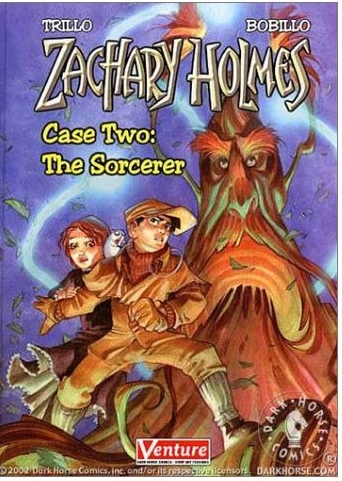
Young detective Zachary Holmes and his mouse assistant Watson were enlisted by Holmes' friend Diana and the tree-bound spirit of Merlin to stop an evil ghost, Lord Moriarty, from killing Queen Victoria with the sword Excalibur in Zachary Holmes - Case Two: The Sorcerer (published in the U.S. by Dark Horse Comics, 2002). The spirits of King Arthur and Robin Hood also appear in the story, which is probably most memorable for its depiction of Merlin as an anthropomorphic tree.
DC's top-hatted "Mistress of Magic" traveled through time to Camelot and encountered Lancelot and Gawain in a story that appeared as a back-up feature in Supergirl v.1, #1 (1972). She also shared an adventure with descendants of Merlin and Arthur in Supergirl v.1, #4 (1973). (Sources: e-mail from Orville Eastland, the Grand Comics Database, the Arthurian Annals, and DarkMark's Zatanna index.)
Last updated 9/20/15. E-mail your comments and suggestions to the author, Alan Stewart .